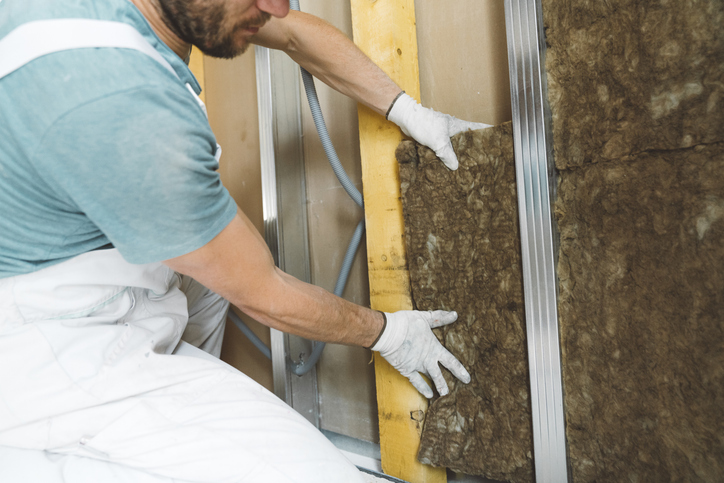The cavity wall closer mistake you won't want to make when fitting your insulation
Getting it right the first time is essential when installing cavity wall closers

There are a number of factors self-builders must take into account if they want to know how to install cavity wall closers effectively.
Closers are an essential part of any cavity wall because they prevent heat from being lost through the gap and stop moisture and damp from getting in. The energy efficiency of buildings is an issue all self-builders need to be aware of and placing closers correctly can minimise heat loss – reducing household bills, and preventing moisture penetration, nipping damp problems in the bud.
DIY Instagram influencer Scott Baggaley recently shone a light on the issue of first time self-builders failing to leave enough of a gap for the cavity wall closers when installing insulation and being forced to trim it back – a time-consuming and frustrating process.
Thomas Goodman, a construction expert at myjobquote, spoke to Homebuilding and Renovating about the pitfalls of closer installation and how to get it right first time without any embarrassing and time-consuming mishaps.

Thomas Goodman has worked as a property and construction expert for MyJobQuote for six years and has worked in the construction industry for more than 20 years. Thomas continues to work on building projects, while also providing expert construction and property advice to industry professionals and DIY enthusiasts
What are cavity wall closers?
Cavity wall closers act as a seal around openings in cavity walls. This includes windows and doors.
Closers come as rigid strips, usually made from uPVC, backed with insulation. They’re an important part of modern homes as they minimise heat transfer, helping your home stay warm, says construction expert Thomas Goodman. They also reduce water ingress, condensation, and damp. Some closers are also fire-rated to improve safety.
Pre-formed cavity wall closers usually feature one or two T-shaped grooves and are designed to be fitted during the construction of the wall, like these pre-formed closers that can be purchased fairly inexpensively on Wickes.
Get the Homebuilding & Renovating Newsletter
Bring your dream home to life with expert advice, how to guides and design inspiration. Sign up for our newsletter and get two free tickets to a Homebuilding & Renovating Show near you.
Ties are slotted into the grooves and set into the mortar to help fix the closers in place. There are also variable-width closers, which can be cut down to size so they snugly fit into your wall cavity. This type is designed for installation after the wall has been built and can be purchased at online retailers such as the insulation superstore.
Some come with a flange on either side that sits on the brick and blockwork, creating a seal like these flange cavity closers at Travis Perkins. Others have just one flange, like these single-flange closers from Travis Perkins, and can be used with windows that are set back in the wall.
The mistake people make with cavity wall closers
It is a common mistake to not take into account the width of closers when the insulation is installed, forcing installers to cut the insulation back after it has been fitted to accommodate the closers, as first time self builder and DIY influencer Scott Baggaley discovered.
"I've met so many builders who've done this first time," Scott explained in a clip warning others to avoid making the same mistake. "I'm having to cut back all of my insulation about 15mm so my cavity closers go in. And it's not just on the windows, it's on the door as well."
Conversely, you need make sure you don’t cut too much width off the insulation, otherwise it won’t have a tight fit. Loose fitting closers won’t offer nearly as much protection from cold bridging or heat loss, adds construction expert Thomas Goodman.
Closers need to be fixed in place with masonry fixings along the flange. Not doing so will mean they’re prone to movement and gaps opening up after your door or window has been fitted, he explains.
You should also limit the number of butt joints you use as the more gaps you have, the worse your closers will perform.
So, it’s a good idea to use one complete strip along each vertical or horizontal section of your opening, rather than push two or more smaller strips together.
How to prep for cavity wall closers
It is important to measure and correctly prepare the width of the cavity to ensure the correct size is selected.
The cavity closer should be cut to the appropriate length but a small gap – usually around 10mm – can accommodate any potential movement or settling, adds Goodman.
The cavity closer should be placed horizontally across the cavity opening to ensure it sits tightly against the inner and outer walls. It may be easier to use spacers or wedges to hold it in place temporarily while it is fixed using screws or wall plugs.
How to install cavity wall closers
The flanges of the cavity wall closer need to sit flush against the wall opening, with the insulated section pushed into the cavity, construction expert Thomas Goodman says, adding that it’s therefore important to make sure there’s nothing impeding it, such as wall insulation or lumps of mortar.
Installers should closely inspect the cavity closer to ensure it is securely fixed and any excess material should be trimmed. It may also be necessary to apply additional sealing to any remaining gaps.
Sam is based in Coventry and has been a news reporter for nearly 20 years. His work has featured in the Mirror, The Sun, MailOnline, the Independent, and news outlets throughout the world. As a copywriter, he has written for clients as diverse as Saint-Gobain, Michelin, Halfords Autocentre, Great British Heating, and Irwin Industrial Tools. During the pandemic, he converted a van into a mini-camper and is currently planning to convert his shed into an office and Star Wars shrine.

